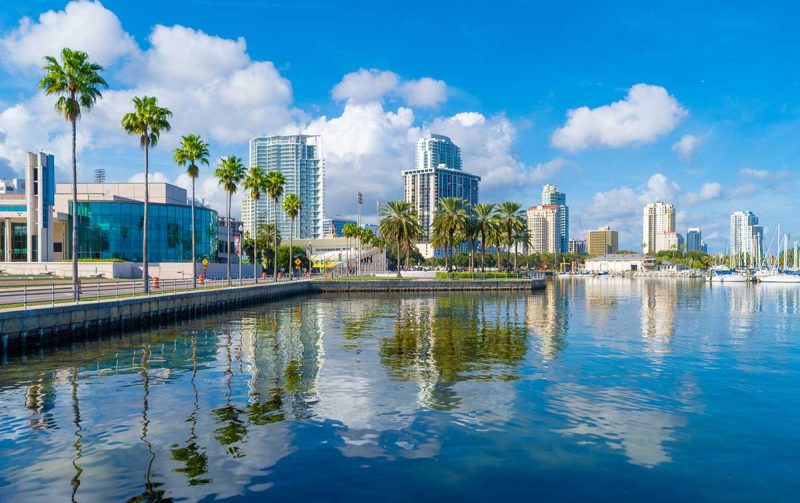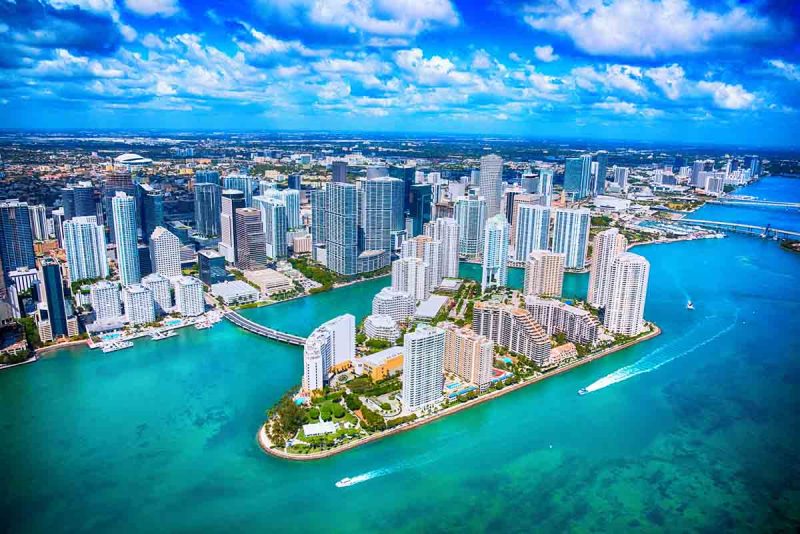Florida remains a hotspot for aspiring real estate agents, offering no state income tax, year-round sunshine, and a thriving economy. Whether you’re starting your real estate career or looking to grow your business, knowing the top markets in 2025 is key to success.
This guide highlights Florida’s best-performing real estate markets, providing up-to-date data and expert insights to help you identify opportunities and position yourself as a trusted agent in today’s dynamic industry.
Key Takeaways
-
Orlando and Central Florida Lead Recovery: Orlando shows remarkable resilience with 3% year-over-year price appreciation and moderate inventory levels, making it ideal for both appreciation and cash flow opportunities.
-
Southwest Florida Offers Value Opportunities: Naples, Fort Myers, and Cape Coral present buyer-favorable conditions with significant price adjustments creating entry points for long-term investors.
-
Tampa Bay Maintains Strong Fundamentals: With corporate relocations continuing and diverse housing options, Tampa offers balanced appreciation potential and rental returns.
-
Insurance Costs Drive Geographic Shifts: Rising insurance premiums favor inland properties and newer construction with hurricane-resistant features, reshaping traditional market preferences.
-
Central Atlantic Coast Provides Coastal Value: The Space and Treasure Coasts offer the best combination of affordability and appreciation potential for coastal properties statewide.
Current State Of The Florida Real Estate Market
Florida’s real estate landscape in 2025 presents a complex picture with significant regional variations. According to recent data from Redfin, the statewide housing market shows mixed signals with median home prices at $404,100, down 1.4% year-over-year.
The market has shifted from the explosive growth of previous years to a more balanced environment, with homes spending an average of 75 days on market (up 15 days from last year) and inventory levels increasing by 9.2% year over year.
Despite this cooling trend, Florida remains a migration magnet, with cities like Orlando, Tampa, and Sarasota continuing to attract residents from across the country. This ongoing demand helps maintain price stability in many areas despite economic headwinds.
Criteria for Evaluating Real Estate Markets
When assessing Florida’s best real estate markets in 2025, several key factors determine growth potential and investment viability.
Economic indicators
Job growth remains crucial, as markets with diverse employment sectors show greater resilience. An increase in population due to net migration often leads to higher demand for housing, as more people move into an area. At the same time, regions where household incomes are steadily rising tend to experience more sustainable increases in home prices over time.
Housing market metrics
Current inventory levels sit at 5.4 months supply statewide, with 6 months considered balanced market conditions. Days on market vary significantly by region, ranging from 39 days in competitive areas to over 90 days in others. Year-over-year price changes reveal which markets are appreciating versus experiencing corrections.
External factors
Insurance costs have become a major consideration affecting affordability and investment returns. Climate resilience increasingly impacts long-term property values, while infrastructure development typically signals future market outperformance.
1. Orlando and Central Florida
Orlando leads Florida’s real estate recovery in 2025, showing remarkable resilience despite broader market challenges. Orlando’s median home price stands at $375,000 (up 3% year-over-year) with inventory at a moderate 4.2 months supply.
Why it’s thriving
The region benefits from a diversified economy beyond tourism, including growing tech and healthcare sectors. Strong population growth continues, with Orlando adding over 76,000 new residents recently. Orlando has affordable housing options compared to coastal markets.
Key neighborhoods to watch
Lake Nona continues experiencing growth driven by Medical City and technology development. Winter Garden offers family-friendly communities with strong school ratings. Dr. Phillips and Windermere represent established areas maintaining value with luxury appeal.
Orlando offers balanced opportunities for both property appreciation and rental cash flow, particularly in growing suburbs with strong rental demand from young professionals and families.
2. Tampa Bay

Tampa Bay remains a top performer in 2025 with a median home price of $431,000 (up 5.1% year-over-year). The region benefits from 5.4 months of inventory, creating more balanced conditions than during the pandemic peak.
Why it’s attractive
The area maintains a strong job market with corporate relocations continuing from higher-cost states. Tampa ranks #10 nationally in terms of migration interest, according to recent studies. The region offers diverse housing options from urban condos to suburban communities, remaining relatively affordable compared to South Florida markets.
Emerging opportunities
Wesley Chapel presents a growing suburb with new construction and a 4.8-month inventory. St. Petersburg shows a slightly cooling market (-1.5% year-over-year) but maintains strong lifestyle appeal. Riviera Beach has been highlighted as an emerging luxury market by industry experts.
Tampa provides an excellent balance of appreciation potential and rental returns, particularly in areas with new infrastructure development and employment center proximity.
3. Southwest Florida
Southwest Florida presents unique opportunities in 2025 as the market rebalances after significant price corrections. Median prices in this region have decreased year-over-year: Naples ($600,000, -1%), Cape Coral ($366,000, -6%), and Fort Myers ($349,999, -7%).
Why it’s compelling now
Current buyer’s market conditions feature 7.3 months of inventory, creating negotiation opportunities. Pending sales jumped 20% year-over-year, indicating renewed buyer interest. Luxury waterfront properties trade at more accessible price points than 2023-2024 peaks, while strong rental demand persists for single-family homes.
Value opportunities emerging
Bonita Springs leads the recovery with a 71% jump in pending sales year-over-year. Osprey and Nokomis show price adjustments creating value opportunities (-6.5% and -8% respectively). Cape Coral presents buyer-friendly conditions, with major real estate platforms ranking it among the top markets for buyers in 2025.
This region offers significant value opportunities for long-term investors who can navigate higher insurance costs and remain patient during market recovery cycles.
4. Central Atlantic Coast
The Space and Treasure Coasts represent some of Florida’s best coastal values in 2025. This area has seen population gains of 18,000+ (3% growth) while maintaining more affordable price points than Florida’s Gulf Coast markets.
Competitive advantages
Median home prices remain significantly lower than Gulf Coast equivalents, supported by a stable job base including aerospace, technology, and healthcare sectors. The region exhibits less tourism dependence than many Florida coastal areas and ranks #8 nationally in terms of net migration.
Market opportunities
Palm Bay offers an affordable entry point at $273,000 median price. Melbourne provides stable pricing with a strong employment base anchored by the space industry. Vero Beach has experienced significant price adjustments, creating opportunities in the luxury segment.
This region offers the best combination of affordability and appreciation potential for coastal properties throughout Florida, making it attractive for both primary residences and investment properties.
5. Miami and South Florida

Miami presents a complex picture in 2025, with the market experiencing a correction phase after years of explosive growth. Miami’s median home value reaches $562,810 (down 3.2% year-over-year) with homes taking an average of 72 days to sell, up from 45 days last year.
Market dynamics
International appeal remains strong despite market adjustments, with the luxury segment showing resilience through just a 2.7% price decline. Cash buyers account for 42.1% of transactions, indicating strong financial capacity among purchasers. Significant inventory expansion creates opportunities in certain submarkets for strategic buyers.
Neighborhood focus areas
The Tropical Park area shows properties near amenities, maintaining better value retention. Little Gables emerges as a neighborhood with strong fundamentals for future growth. Lauderdale Lakes earned recognition as the 4th best market for first-time homebuyers according to REALTOR.com analysis.
Miami requires careful neighborhood selection and market timing, with opportunities for value purchases in areas featuring lower insurance costs and strong rental demand from the international business community.
Market Growth and Trends to Watch
Several key trends are reshaping Florida’s real estate landscape as we move through 2025 and into 2026.
Shifting buyer demographics
Florida’s buyer profile continues evolving with younger buyers becoming increasingly active, particularly in affordable markets like Jacksonville and Lakeland. International investment remains steady despite market cooling, with buyers from Canada, Latin America, and Europe maintaining interest. Remote workers continue relocating to Florida, prioritizing lifestyle benefits and tax advantages over proximity to traditional employment centers.
Price stabilization patterns
After significant price growth from 2021 to 2023, Florida’s market is finding new equilibrium points. Statewide median prices have decreased 1.4% year-over-year to $404,100, though regional variations persist. Some areas like Orlando (+3%) and Tampa (+5.1%) continue appreciating while others like Naples (-1%) and Fort Myers (-7%) are correcting from previous highs.
Inventory expansion impact
Florida’s housing supply has increased significantly, with statewide inventory reaching 5.4 months, approaching the 6-month balanced market threshold. New construction activity is moderating but remains strong in growth corridors. Price reductions affect 29.8% of Florida listings, creating negotiation opportunities for prepared buyers.
Insurance And Climate Considerations
Perhaps the most significant market factor in 2025 involves insurance costs and climate resilience planning.
Rising insurance premiums have become a major affordability factor, particularly in coastal and flood-prone areas. This geographic impact means inland properties now command premiums due to lower insurance costs, reshaping traditional market preferences. Modern building standards featuring hurricane-resistant construction maintain value better than older properties.
Smart investors and homebuyers are factoring these considerations into their decision-making processes, often choosing newer construction or inland locations to optimize long-term carrying costs.
Investment Strategies For Success
For real estate investors
Focus on cash flow potential over speculative appreciation in the current market environment. Factor rising insurance costs into all investment calculations from the beginning. Consider inland properties with lower carrying costs for better returns. Look for value-add opportunities in properties needing modest improvements within strong rental markets.
For homebuyers
Take advantage of the fall and winter seasons for better negotiating conditions. Get insurance quotes before making offers, particularly in coastal areas where costs vary significantly. Research neighborhoods focusing on areas with strong schools, employment centers, and planned infrastructure improvements. Use increased inventory and days-on-market statistics to negotiate a favorable price and terms.
Why Florida Remains A Real Estate Powerhouse
Despite current market adjustments, Florida’s fundamental appeal remains strong. The state benefits from ongoing population growth, as it remains a top destination for domestic migration. Economic diversity extends beyond tourism into healthcare, technology, finance, and other growth sectors. Tax advantages, including no state income tax and homestead exemptions, maintain a strong appeal for residents and investors. Quality of life factors, including climate, recreation, and cultural amenities, continue attracting new residents.
For real estate professionals, the current market presents both challenges and opportunities. Success in 2025-2026 will favor those who understand local market dynamics, provide exceptional value to clients navigating complex decisions, and focus on long-term fundamentals rather than short-term market fluctuations.
Frequently Asked Questions
What are the most affordable markets in Florida for first-time buyers?
Lauderdale Lakes, Jacksonville, Ocala, and parts of Central Florida offer the best combination of affordability and growth potential for first-time buyers in 2025, with median prices often below $300,000.
How does job growth influence real estate opportunities in Florida?
Markets with diverse employment sectors, like Orlando, Tampa, and Jacksonville, show greater resilience and sustainable growth compared to areas heavily dependent on tourism or retirees, as economic diversity provides stability during market fluctuations.
Are there cities with untapped rental market growth potential?
Central Florida cities like Lakeland, Ocala, and parts of Jacksonville offer strong rental growth potential with lower entry prices than established markets, particularly appealing to investors seeking cash flow opportunities.
How are insurance costs affecting the Florida market in 2025?
Rising insurance premiums have become a major factor in purchase decisions, with inland properties and newer construction commanding premiums due to lower insurance costs, fundamentally shifting buyer preferences away from traditional coastal markets.
What impact will interest rates have on Florida’s market through 2026?
While rates remain elevated in 2025, anticipated decreases in 2026 could stimulate additional buyer activity, particularly in mid-market segments most affected by financing costs, potentially accelerating market recovery in price-sensitive areas.
Take The Next Step In Your Real Estate Career
Ready to succeed in Florida’s dynamic real estate market? The knowledge and expertise you gain today will determine your success tomorrow. Whether you’re enrolling in your beginner real estate classes or advancing your existing career, proper education and licensing provide the foundation for thriving in this competitive industry.
Gold Coast Schools has been Florida’s premier provider of real estate education since 1970, helping over 500,000 professionals launch and advance their careers. Our comprehensive programs, expert instructors, and flexible learning options prepare you for success in any market condition.
Disclaimer: This report is informed by a blend of trusted perspectives, including insights from seasoned real estate instructors who serve as local experts and professionals deeply embedded in the Florida housing market. Complementing their expertise are data and trends drawn from leading real estate publications, comprehensive market analyses, and reputable industry reports. Together, these sources provide a well-rounded depiction of the Florida real estate landscape, ensuring that buyers, investors, and professionals alike have access to actionable and reliable information.

